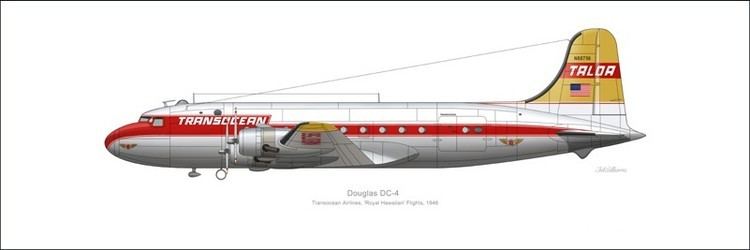TL TALOA Operating bases Ceased operations 1960 | Commenced operations 1946 Founded 1946 Date of operation 1946 | |
 | ||
Headquarters Oakland, California, United States | ||
Transocean Air Lines was an Oakland, California-based airline that operated from 1946 until 1960.
Contents
History
At its height the Transocean organization included ten companies, making it the first aviation conglomerate. The airline employed 1,500 persons. Including the personnel of their subsidiary companies, the total number exceeded 6,700. Transocean’s gross annual sales climbed as high as $50 million.
By April 1958, after 12 years of business, Transocean’s aircraft had flown a total of 1,290,966,900 passenger miles, 126,990,642 cargo ton-miles, and 66,828,237 aircraft miles. Transocean Air Lines became the largest supplemental air carrier in the world, employing at its peak over 6,700 workers at 57 bases around the globe.
Beginning
"Word that a new airline was in the offing spread quickly with Captain Nelson's first call, and the response was overwhelming. Looking for employment and happy that the war was over, applicants from all branches of the armed services rushed to the Oakland Airport, hoping to land a job with this fledgling airline. I remember seeing the long rag-tag line that stretched away from the International Terminal Building, out the door, down the steps, and all the way back to the airport restaurant, a distance of a hundred yards or more. Many were in civilian clothes but others, still wearing various military uniforms, were trailing duffel bags. "Yes, indeed, those were halcyon days. We were all young and overflowing with enthusiasm for what we saw as a chance to break ground with a new airline. We wanted to have our place in the sun as pioneers and innovators. The romance and promise of commercial flying... the excitement and exuberance of this bunch of young hopefuls would provide the spirit that was soon to become Transocean Air Lines.""We fly anything, anywhere, anytime" was the motto of Nelson and Transocean. Their expertise in the mass movement of people, freight, and live cargo was developed by creative planning and by trial and error. The successful completion of the first contracts established the airline's reputation as "can do" people.
The first aviation conglomerate
Known throughout the industry as the flying airline president, Nelson was the only top executive of a major airline during the late 1940s to hold transport pilot ratings. He spent much time away from his desk in search of business or visiting Transocean's outposts, all the while keeping an eye out for profitable enterprises to add to his ever expanding international business empire, or airplanes to add to the fleet.
Soon after taking to the skies in 1946, Nelson began to expand into other areas. By the mid-1950s and after acquiring several subsidiary businesses, some of the men closest to Nelson began to express concern that perhaps Transocean had overdiversified and that the company was in danger of decline. From their inception in 1946 until as late as 1959, Transocean enjoyed success in most of their endeavors. The airline and its divisions often received commendations from both military and civilian groups for their contributions to aviation.
A crew once left Oakland, California for Taiwan in a DC-4 loaded with 12,000 pounds of gunpowder for General Chiang Kai-Shek’s Nationalist Chinese Army, then ferried the airplane to Hong Kong to pick up a load of Chinese cedar chests and fly them west to Rome, Italy. Within hours of the delivery of the cedar chests, the airplane departed full of Italian seamen bound for New York to rendezvous with an ocean freighter.
Bankruptcy
Transocean airlines went bankrupt in 1960.
Former staff
A half century after the airline’s demise, nearly 200 of their former employees – and now their children and grandchildren – were members of the Taloa Alumni Association. The Transocean group meets for a reunion every year.
Fleet
Aircraft operated by Transocean Air Lines Total: 146 aircraft, of which 68 were DC-4s.
In addition, Taloa Academy of Aeronautics had a total of 56 single-engined trainers at its peak.
Accident history
During almost 14 years of continuous and concentrated aviation and airline activity, totaling in excess of 70 million aircraft miles, more than a billion and a half passenger miles, and over 85 million cargo-ton miles (often in areas with few or non-existent navigational aids or ground installations), Transocean's total casualties were 90 passengers and 16 crew.
